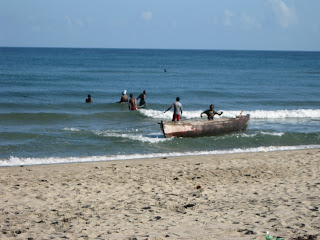From the top: Almuerzo (lunch) en Tela, nuestra casa (our house) en Cusuna, el bote (the boat), Pablo disfrutando el coco (Pablo enjoying coconut), una mujer de Cusuna trabajando con la pesca (a woman in Cusuna working with the fish), una vista de Cusuna (view of Cusuna), la catarata (waterfall) en Panacam, otra vista de Cusuna (another view of Cusuna).
La semana pasada, tomamos un viaje muy diferente, pero también muy interesante y divertido. La mayoría de la semana fue pasada en Cusuna, un pueblo pequeño por la costa Caribbean de Honduras. El sábado, salimos Santa Lucia a las cinco por la mañana por un bus amarillo de la escuela y viajamos por todo el día, parando por almorzar en Tela, un cuidad con playas bonitas y un jardín botánico extensivo. Pasamos un noche en un hotel (las duchas calientes eran un regalo), y entonces continuábamos nuestro viaje a Cusuna. Después tres horas por calles tierras y muchos ríos sin puentes, llegamos a Cusuna.
Cusuna es una comunidad garifuna, que significa que la gente allí son descendientes de esclavos Caribéanos. El pueblo es muy pobre, sin electricidad y con una economía substantiva. La gente, incluyendo los niños, se despierte a las tres o cuatro por la mañana y pasa el día pescando, cortando yuca, y preparando la comida para sobrevivir. En todos partes, habían muchísimos niños, algo un poco incómodo. Los niños fueron lindos, pero también muy exigentes y agresivos. Para ser honrada, no sabíamos lo que actuar con ellos. El viaje nos forzó reflejar y pensar hondo en las causas por la pobreza y nuestra responsabilidad para combatirlo en el mundo.
Lunes tomamos un descanso de Cusuna y fuimos a Sangrelaya, otro pueblo garífuno, pero más desarrollado. Primero, dieciocho de nosotros amontonamos en el que básicamente era una canoa con un motor por el viaje de treinta minutos. Luego en Sangrelaya, entrevistamos el pastor, cortamos algunos cocos con machetes, y aprendimos como hacer casabe, una tortilla especial de yuca. Todo el día fue un poco como estar en Geográfica Nacional.
Martes quedamos en Cusuna y aprendimos más sobre el pueblo. Fuimos a la playa, vimos la clínica y la escuela, entrevistamos algunos de la gente, y asistimos un sesión de punto, la baila tradicional garifuna. Las mujeres garifunas son insistentes, y por eso, muchas de nosotros bailamos también.
Terminamos nuestro viaje con un día en Panacam, una montana hermosa casi medio entre Cusuna y Tegucigalpa. La caminata por cataratas y vistas veas fue la manera perfecta para concluir nuestra viaje. Lunes empecemos nuestras clases reales. ¡Deséenos suerte!
Last week, we took a trip very different, but also very interesting and fun. The majority of the week was spent in Cusuna, a small village on the Caribbean coast of Honduras. On Saturday, we left Santa Lucia at five in the morning in a yellow school bus and traveled all day, stopping for lunch in Tela, a city with beautiful beaches and an extensive botanical garden. We spent the night in a hotel (the hot showers were a treat), and then continued our journey to Cusuna. After three hours of dirt roads and many bridgeless rivers, we arrived in Cusuna.
Cusuna is a Garífuna community, meaning that the people there are descendents of Caribbean slaves. The village is very poor, without electricity and with a subsistence economy. The people, including the children, wake up at three or four in the morning and spend the day fishing, cutting yucca (sort of like a dry, stringy potato—it tastes better than it sounds), and preparing food in order to survive. Everywhere there were an incredible amount of children, something a little bit uncomfortable. The kids were cute, but also very demanding and aggressive. To be honest, we didn’t know how to act with them. The whole trip forced us to reflect and think deeply about the causes of poverty and our responsibility in combating it in the world.
Monday we took a rest from Cusuna and went to Sangrelaya, another Garífuna village, albeit more developed. First, all eighteen of us piled into what was basically a canoe with a motor for the thirty minute trip. Later in Sangrelaya, we interviewed the pastor, hacked open some coconuts with machetes, and learned how to make casabe, a special tortilla made from yucca. The whole day was a little bit like being in National Geographic.
Tuesday, we remained in Cusuna and learned more about the culture there. We went to the beach, saw the school and clinic, interviewed some of the people, and attended a demonstration of punto, the traditional Garífuna dance. The Garífuna women are pretty insistent, so many of us danced as well.
We finished our trip with a day in Panacam, a beautiful mountain about halfway between Cusuna and Tegucigalpa. The hike by waterfalls and gorgeous views was the perfect way to end our excursion. Next week we start our real classes. Wish us luck!









